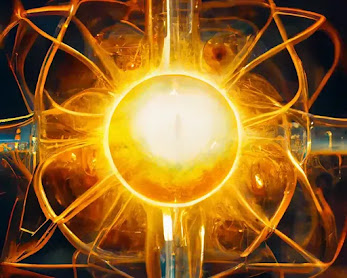As Dense as It Gets: Using String Theory To Create a New Model for Matter
International Conference on Nuclear Physics
A new model for matter in neutron star collisions.
After a massive star burns its fuel and explodes as a supernova, an exceedingly compact object known as a neutron star may form. Neutron stars are very dense: to get the density within them, one would have to shrink a large body like our sun to the size of a city like Frankfurt. In 2017, gravitational waves, the small ripples in spacetime that are produced during a collision of two neutron stars, could be directly measured here on earth for the first time. However, the exact composition of the ensuing hot and dense merger product is unknown. For instance, it is currently unknown if quarks, which are normally trapped in neutrons, may emerge in free form after the collision.
The Asia Pacific Center for Theoretical Physics in Pohang, South Korea, Dr. Matti Järvinen, Dr. Tuna Demircik, and Dr. Christian Ecker from the Institute for Theoretical Physics of Goethe University Frankfurt, Germany, have now created a new model that allows them to GET one step closer to answering this question. They combine models from nuclear physics, which are not applicable at high densities, with a method employed in string theory to describe the transition to dense and hot quark matter.
“Our method uses a mathematical relationship found in string theory, namely the correspondence between five-dimensional black holes and strongly interacting matter, to describe the phase transition between dense nuclear and quark matter,” explains Dr. Demircik and Dr. Järvinen.
“We have already used the new model in computer simulations to calculate the gravitational-wave signal from these collisions and show that both hot and cold quark matter can be produced,” adds Dr. Ecker, who implemented these simulations in collaboration with Samuel Tootle and Konrad Topolski from the working group of Prof. Luciano Rezzolla at Goethe University in Frankfurt.
Reference: “Dense and Hot QCD at Strong Coupling” by Tuna Demircik, Christian Ecker and Matti Järvinen, 31 October 2022, Physical Review X.
#NuclearFusion#NuclearFission#AtomicPhysics#NuclearResearch#RadiationPhysics
#NuclearEngineering#NuclearMedicine#NuclearSafety#NuclearTechnology#NuclearReactor
#NuclearWaste#NuclearTheory#NuclearEx
Visit: https://nuclear-physics.sfconferences.com/
Tumblr: https://www.tumblr.com/settings/blog/nuclearconferences
Instagram: https://www.instagram.com/aman__deep2023/
Pinterest:https://in.pinterest.com/nuclearconferences/_saved/
Linked in: https://www.linkedin.com/in/aman-deep-aa1319268/
Twitter: https://twitter.com/AmanDee71996637
Tumblr: https://www.tumblr.com/settings/blog/nuclearconferences
Instagram: https://www.instagram.com/aman__deep2023/
Pinterest:https://in.pinterest.com/nuclearconferences/_saved/
Linked in: https://www.linkedin.com/in/aman-deep-aa1319268/
Twitter: https://twitter.com/AmanDee71996637




Comments
Post a Comment